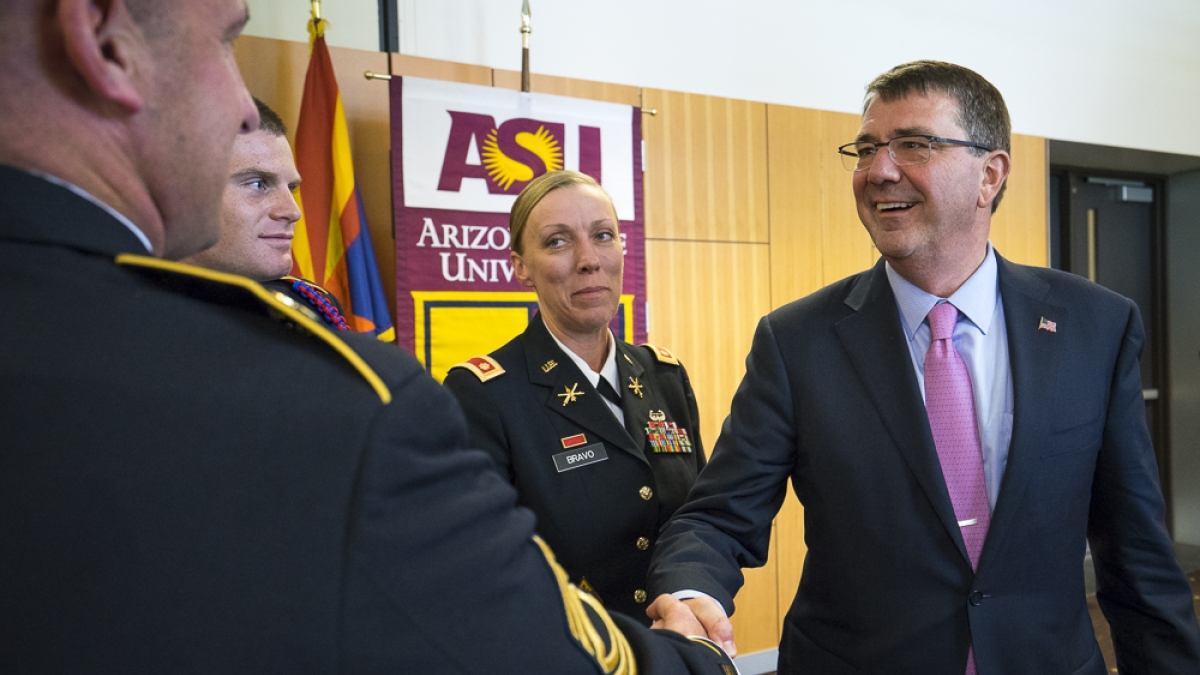US Secretary of Defense visits ASU before historic trip to Asia

Half of all humanity and a majority of the word’s middle class will reside in the Asia Pacific in the next few decades, which is why the United States is bolstering its efforts to protect the region with as much military might as it can muster.
“A growing Asia Pacific is an enormous opportunity for you and your country whether you’re a doctor, an entrepreneur, an engineer, an artist or a software designer,” said U.S. Secretary of Defense Ashton Carter. “The arithmetic is straightforward: 95 percent of the world’s customers for the cures you discover, the software you develop, the articles you write live beyond our borders.”
Carter addressed about 400 Arizona State University students, staff, faculty and local military personnel at the Memorial Union on the Tempe campus on April 6. ASU’s McCain Institute hosted Carter before his first official trip to Asia as head of the Department of Defense and asked him to speak on the links between economic and national security in the Asia Pacific.
“It’s appropriate that I talk about this region at the McCain Institute because John McCain is an American hero, a statesman and a friend of mine,” Carter said. “He’s a staunch supporter when it comes to the welfare of the troops.”
Carter said thanks to McCain, the U.S. and Vietnam have overcome years of mistrust and have forged a military relationship of shared defense capabilities, something that was not possible a decade ago. Carter pointed to Vietnam as an example of the United States' relationship with the Asia Pacific on the eve of what Carter terms a “rebalance” to ensure we do not lose ground in this dynamic region.
“Over the past 70 years, America has not only helped heal the wounds of World War II, we have helped create the stability that has allowed people, economies and countries throughout the Asia Pacific to make incredible progress,” Carter said. “The rebalance, in a nutshell, is about sustaining this progress and helping the region to continue to fulfill its promise.”
A big portion of the rebalance includes a big show of military force and construction of military bases and installations in Japan, Korea and Guam. To accomplish this mission, Carter said the U.S. will deploy several weapons, technologies and a realignment of troops to the region. They include a long-range stealth bomber; a new long-range anti-cruise missile; F-22, P-8, B-2 and B-52 aircrafts; the creation of a “Star Wars”-style railgun, which uses electromagnetic forces rather than explosives to fire rounds; and a couple of Aegis Ballistic Missile Defense ships.
ASU freshman Ray Riebli, who is planning a career in the Marines, said he found Carter’s remarks about the Asia Pacific exciting and well-executed.
“It’s an exciting time for the military in the Asian Pacific, and everything I have heard from Secretary Carter sounds well-planned and thought-out,” Riebli said. “It’s the future and sounds like it’ll be a good opportunity for our country’s economic growth.”
ASU serves more than 4,500 military, veteran and dependent population students and is committed to their success in education. The university has been named a “Military Friendly School” by G.I. Jobs magazine six years in a row.
An earlier version of this story said about 250 people attended the event.

